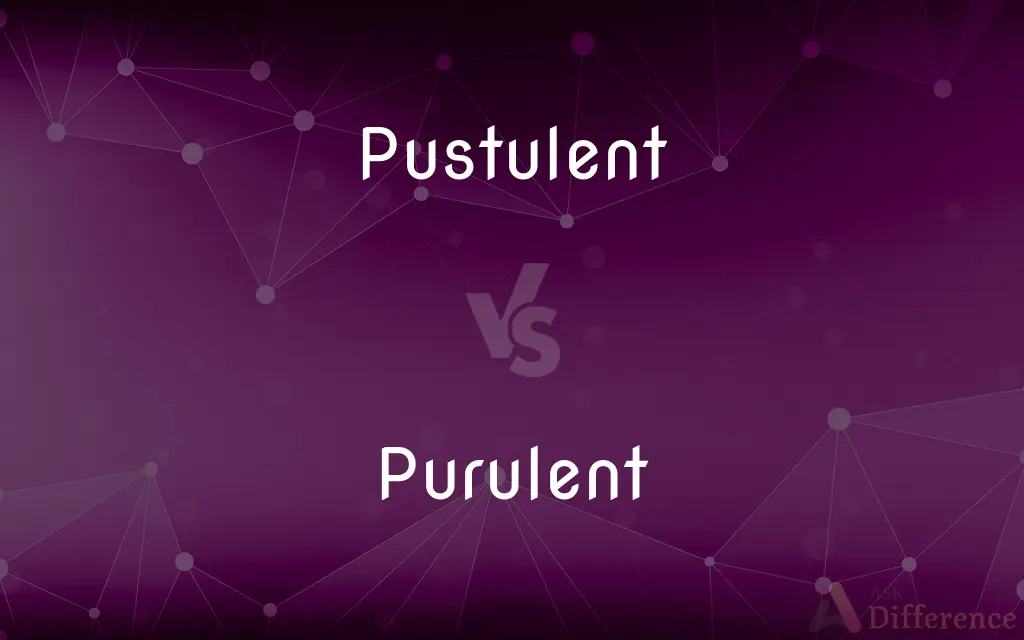Pustulent vs. Purulent — What's the Difference?
By Tayyaba Rehman & Maham Liaqat — Updated on March 27, 2024
Pustulent refers to something filled with or resembling a pustule, while purulent denotes being filled with or producing pus.

Difference Between Pustulent and Purulent
Table of Contents
ADVERTISEMENT
Key Differences
Pustulent describes a condition or surface characterized by the presence or formation of pustules, which are small, raised, often inflamed skin lesions filled with pus. This term is typically used in medical contexts to describe skin conditions or infections that result in such blister-like formations. Whereas, purulent is used more broadly to describe any substance, discharge, or tissue that contains or produces pus, a thick, white or yellowish fluid composed of dead leukocytes, bacteria, tissue debris, and serum resulting from an infection or inflammation.
Pustulent conditions are often the result of localized infections or inflammations that lead to the formation of pustules on the skin or the surface of an organ. These pustules are visible signs of the body's immune response to infection. On the other hand, purulent conditions may not always manifest visibly as pustules but can involve any collection of pus within the body, such as in an abscess, indicating a more generalized response to infection or inflammation.
The term pustulent is specifically associated with the physical appearance and texture of lesions or inflammations that closely resemble pustules. It emphasizes the external, visible aspect of an infection. Conversely, purulent focuses on the content and nature of the discharge or fluid involved in an infection, highlighting its purulence or pus-filled quality, which can be internal or external.
While pustulent conditions are primarily identified through visual examination and the distinct characteristic of pustule formation, purulent conditions may require additional diagnostic methods, such as sampling and analysis of the pus, to understand the underlying cause and nature of the infection or inflammation.
In medical diagnosis and treatment, distinguishing between pustulent and purulent conditions is crucial. Pustulent describes a specific symptom—pustule formation—indicative of certain skin infections or disorders, while purulent pertains to the presence of pus, a sign that can point to a variety of infectious or inflammatory processes within the body.
ADVERTISEMENT
Comparison Chart
Definition
Refers to being filled with or resembling pustules.
Denotes the presence or production of pus.
Context
Mostly used to describe skin conditions.
Broadly applies to both internal and external infections.
Focus
On the appearance and formation of pustules.
On the presence and nature of pus.
Visibility
Pustules are visible and identifiable.
Pus may be internal or external, not always visible.
Implication
Indicates localized infections or inflammations.
Suggests a generalized response to infection or inflammation.
Compare with Definitions
Pustulent
Characterized by the presence of pustules.
The pustulent rash on her arm indicated a severe allergic reaction.
Purulent
Involving or resembling pustules.
The doctor noted the pustulent lesions as a sign of bacterial infection.
Pustulent
Of or pertaining to pustule formation.
The pustulent nature of the wound raised concerns about a staph infection.
Purulent
Of or pertaining to pustule formation.
The pustulent nature of the wound raised concerns about a staph infection.
Pustulent
Involving or resembling pustules.
The doctor noted the pustulent lesions as a sign of bacterial infection.
Purulent
Prone to developing pustules.
Pustulent acne requires targeted treatment to prevent scarring.
Pustulent
Prone to developing pustules.
Pustulent acne requires targeted treatment to prevent scarring.
Purulent
Characterized by the presence of pustules.
The pustulent rash on her arm indicated a severe allergic reaction.
Pustulent
Covered with or having many pustules.
The patient's pustulent skin condition was diagnosed as chickenpox.
Purulent
Covered with or having many pustules.
The patient's pustulent skin condition was diagnosed as chickenpox.
Pustulent
Filled or oozing with pus
A pustulent sore
Purulent
Consisting of, containing, or discharging pus
A purulent discharge
Pustulent
Alternative spelling of pustulant, "producing pustules"
Purulent
Containing, discharging, or causing the production of pus
A purulent infection.
Purulent
(medicine) Consisting of pus.
Purulent
Leaking or seeping pus.
Purulent inflammation
Purulent
Consisting of pus, or matter; partaking of the nature of pus; attended with suppuration; as, purulent inflammation.
Purulent
Having undergone infection;
A purulent wound
Common Curiosities
What is purulent discharge?
Purulent discharge is a thick, often yellowish or greenish fluid produced at infection sites, consisting of pus.
xWhat does pustulent mean?
Pustulent refers to the condition of being filled with or resembling pustules.
How do you treat a pustulent skin condition?
Treatment typically involves antibiotics, antiseptics, and in some cases, drainage or removal of pustules.
Can a wound be both pustulent and purulent?
Yes, a wound can be both pustulent if it has pustules and purulent if it produces or contains pus.
What causes purulent infections?
Bacterial infections are the most common cause of purulent conditions, leading to pus formation.
How do doctors diagnose pustulent conditions?
Diagnosis often involves visual examination, culture tests of the pus, and sometimes biopsy of the pustules.
Can both terms apply to internal conditions?
Purulent is more commonly associated with internal conditions due to pus presence, while pustulent usually describes external skin manifestations.
Are antibiotics effective for both pustulent and purulent conditions?
Antibiotics can be effective if the cause is bacterial; however, the treatment approach depends on the specific condition and its severity.
What is the difference between purulent and serous discharge?
Purulent discharge contains pus, while serous discharge is clear and watery, often seen in non-infectious inflammation.
What hygiene practices prevent purulent infections?
Regular cleaning of wounds, hand hygiene, and avoiding sharing personal items can prevent infections.
Is pustulent a sign of infection?
Yes, pustules typically indicate an infectious or inflammatory process in the skin.
Can a pustulent condition lead to scarring?
Yes, especially if pustules are picked or improperly treated, they can lead to scarring.
What preventive measures exist for pustulent skin disorders?
Preventive measures include maintaining skin cleanliness, avoiding irritants, and using non-comedogenic skincare products.
Is pustulent acne the same as purulent acne?
Pustulent acne refers specifically to acne that forms pustules, whereas purulent acne involves pus production, often seen in severe acne forms.
How do you differentiate between pustulent and purulent conditions in clinical practice?
Differentiation is based on the presence of pustules (pustulent) versus the nature and composition of discharges or lesions (purulent), alongside clinical signs and symptoms.
Share Your Discovery

Previous Comparison
Touque vs. Toque
Next Comparison
Sited vs. CitedAuthor Spotlight
Written by
Tayyaba RehmanTayyaba Rehman is a distinguished writer, currently serving as a primary contributor to askdifference.com. As a researcher in semantics and etymology, Tayyaba's passion for the complexity of languages and their distinctions has found a perfect home on the platform. Tayyaba delves into the intricacies of language, distinguishing between commonly confused words and phrases, thereby providing clarity for readers worldwide.
Co-written by
Maham Liaqat















































